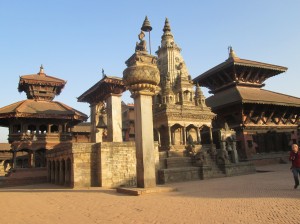Vastu shastra (vāstu śāstra) is the science of architecture and construction, and differs from bastukala (which is the Nepali term for architectural arts). Vastu shastra concerns the positioning of buildings and also interior design based on sections of the house relating to deities with their particular attributes to protect against the inauspicious (in this guise it has been the subject of a horror film by Ram Gopal Varma) and encourage auspicious energies, of benefit to the home and its inhabitants.
Vastu is a very ancient science from the Vedic age when Nepali-Indian religious-spiritual philosophy was formed, of which it is one particular branch. It has some considerable affinities to the Chinese geomantic art of Feng Shui in having the same intent, however whilst both are based on directions systems and elements theories, each differs in these. Both share a guiding ethos in bringing Man into harmony with his surroundings and the cosmos. All of the temples of Nepal as well as other sacred sites, are influenced by Vastu Shastra, and it is a major influencer still upon even contemporary domestic architecture.
Articles:
Nepalese Vastu Shastra is complete understanding of direction, geography, topography, environment & physic for happy & healthy living. it is also study of Astro-Engineering, Which dictates the form, Size & Orientation of a residential , commercial, or official building, in relation to the plot, soil, surroundings & the personality of the house-owner and /or the dweller …. read more.
Source: Vastusense.com website
The Case of Vastu: Transforming the Traditional
Once derided by modern home-makers as traditional and unnecessary, the rising popularity of Vastu Shastra provides a clear example of how ideas and practices associated with tradition can be remade into current fashion. As an architectural philosophy, vastu has traveled across diverse times and regions. Consequently, it has a thousand different interpretations and applications. When I refer to it, I am following John Gray’s book Domestic Mandala4 , where he spells out several different applications of vastu – from the orientation of the house, the ritual commencement of building (jag puja); the ritual entrance of the house (griha prabesh puja); and finally, the alignment of the house’s interior with the cosmological position of deities. Typically though, when I ask informants who are building houses if they are applying Vastu Shastra, they refer to this last part, the interior layout….. read more.
Article by Andrew Nelson
Source: Spacesnepal.com


